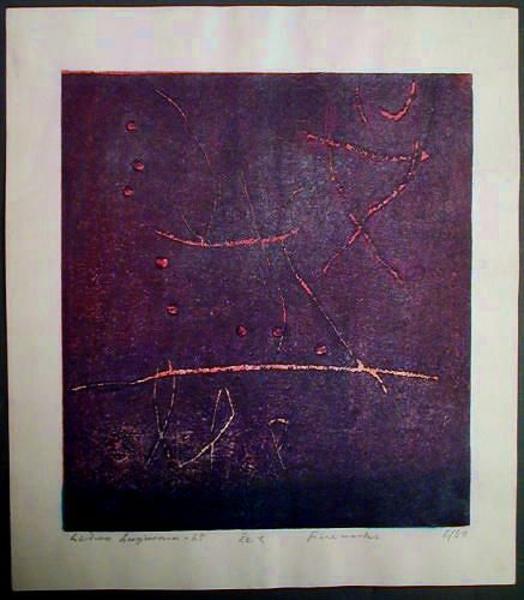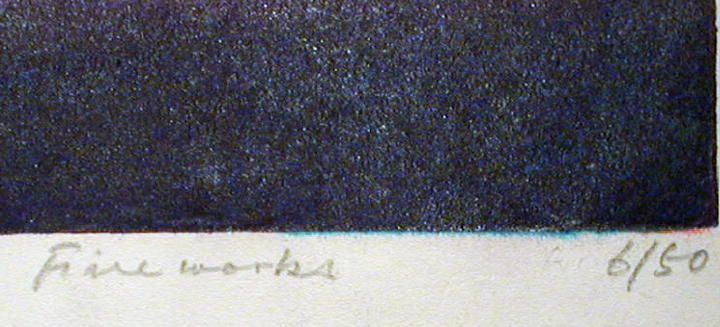| | |
| Artist: | Hagiwara Hideo (b. 1913) |
| Title: | Fireworks |
| Series: | |
| Date of first edition?: | 1965 |
| Publisher (first edition)?: | Self |
| Publisher (this edition)?: | Self |
| Medium (first edition): | Woodblock |
| Medium (this edition): | Woodblock |
| Format (first edition): | Large Oban
|
| Format (this edition): | Large Oban |
| DB artwork code: | 32624 |
| Notes (first edition)?: |
|
| Notes (this edition)?: |
| The following information was taken from the original web listing of this artwork. Note that there may be some inaccuracies:
This is a original modern Japanese Woodblock print by Hideo Hagiwara (born 1913) titled "Fireworks". The print is pencil signed by the artist , dated 1965, titled in Kanji and English, and edition 6/50. The print is in fine condition. Excellent color, impression, and bleedthrough. Extensive use of guaffrage and mica for a pearlescent sheen in the image. No foxing, toning, or folds. The print is not setdown or trimmed. There is one soft "printer's crease" in the left margin which does not enter or affect the image. These creases are common on Hagiwara prints due to the printing technique he used and how the paper reacts to the technique. The photos do not do justice to the rich pearlescent purple color. Yoseido gallery tissue tag still affixed to the verso. Image size is 11" x 12.25", paper size is 13.5" x 15.5".
|
|
| Artist Bio: |
Hideo Hideo Hagiwara (萩原 英雄, 1913 – November 4, 2007) was a Japanese artist who worked mainly with woodblock prints. He was born in Kōfu, Yamanashi. Between 1921 and 1929 he lived in Korea and Manchuria. He studied at the Tokyo School of Fine Arts, where he graduated at the Oil Painting Section in 1938. While still there he attended Un'ichi Hiratsuka's extracurricular woodblock printing course, and in the same year he became quality controller at the Takamizawa Woodblock Print Company. He wasconscripted into the army in 1943. In 1945 he had lost his house, his atelier and nearly all his early works. Around 1950 he had sufficiently recovered to start painting again. At the same time he started making Sōsaku Hanga, both figurative and abstract prints. He was known as a constant innovator and he was generally considered one of the best post-WWII Sōsaku Hanga artists.
|
|




